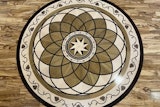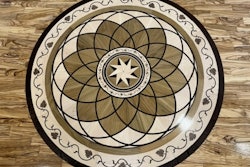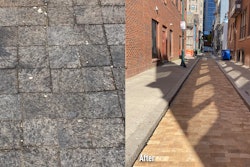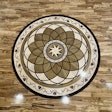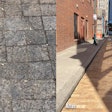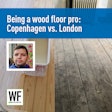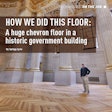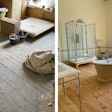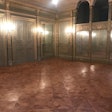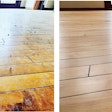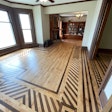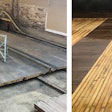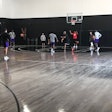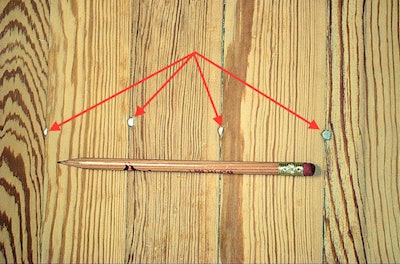
(This blog is directed to that group in the wood flooring industry with sore knees, sore backs and callouses on their hands. We often feel like we are struggling to hold onto a market that reacts every time the prime rate hiccups, a contractor is looking to save $100 or a decorator sees nothing but ebonized floors. I want you folks to stop, turn around and look behind you. You just may be looking at a market that dwarfs anything you, or the industry, have seen in a long time.)
Since 1907 through the late 1980s, roughly 23.5 billion square feet of oak, maple, beech, birch and pecan flooring was installed. This doesn’t include plank, parquet or pine flooring, so it’s likely this number is in the 30 billion square feet range. Even if you figure we’ve lost 25 to 30 percent of that number to attrition, that still leaves a phenomenal amount of wood flooring that needs attention. Ironically, one of the largest markets in the wood flooring industry is the growing market of old floors and what can be done with them.
For decades, one of the most repeated questions about wood floors was how many times they could be sanded. To be honest, as long as there was wood to sand, we simply kicked the can on down the road. We are rapidly approaching the end of that road, and it’s time to face the music. One thing we know for sure is that we have to change some techniques.
Old floors represent a challenge because sanding them with belt sanders and edgers is not going to be an option. Over many decades, we have methodically removed layers of wood from the floors as we made them look better. No other surface in a structure loses so much mass or structural integrity while it’s being restored. The weaker the surface, the more likely it will start splitting and splintering. It’s time to rethink the process.
Know Your Talking Points
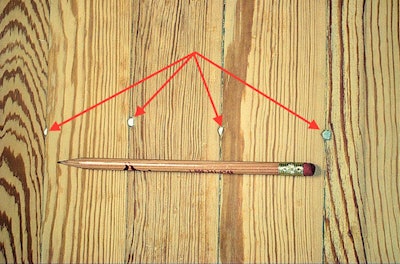 Fastener heads like these are a sure indication there is no wood left to sand on an old floor.
Fastener heads like these are a sure indication there is no wood left to sand on an old floor.
On your walk through with a homeowner, you need to know what to look for to make your case. The first indication are the “hidden nails” that went into the top of the tongue of the tongue and groove. If you’re sanding the floor, you hear/see them as your sandpaper shines them up. They may not be as conspicuous on a finished floor, especially if the floor’s been stained or the holes filled. Look for any signs, and then see if there’s a pattern, as they often are nailed into the joist.
 These fine cracks are the precursor to the wood shearing off entirely, like in the photo below.
These fine cracks are the precursor to the wood shearing off entirely, like in the photo below.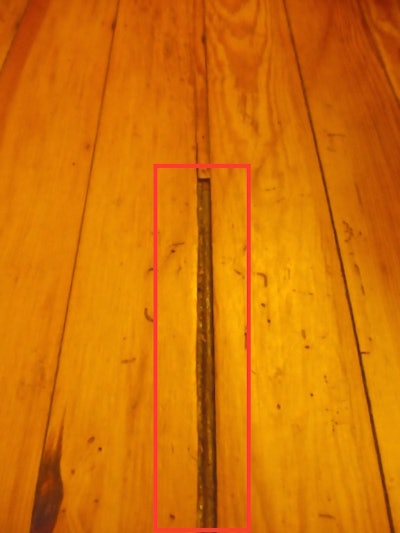
Plan B
For decades, the “go-to” machines for sanding/finishing have been the belt sanders and edgers. And they are the primary reason we’ve lost so much wood. Understand, I’m not being critical of these pieces of equipment. I’ve been running them for over 40 years. They are incredibly quick and efficient at doing what the workers in Gustav Caillebotte’s “The Floor Scrapers” were doing with block planes and scrape blades in his famous painting of 1878. The result is the same either way; the floor is weakened to the point it finally falls apart.
I pretty much parked my belt sander several years ago and have sold all my edgers. I rely on what I call secondary sanders. These machines include Cherryhill’s Superbee and U-Sand, Lagler’s Trio and Clarke’s 3-DS and EZ Orital Sander, to name a few. We are likely to see more equipment of this type entering the market. These machines slow the process down and require more sandpaper to do the work. But the advantage they give you is in minimizing the loss of any wood. You are able to manage the removal process much more effectively, and “managing the removal process” is going to be the new mantra.
Be prepared for more time spent in prepping the floor. The amount of time needed will also vary depending on the amount and type of finish you are removing. In the past, most of us have had our simple, straightforward square-foot price and that usually worked fine. With this approach, you need a seasoned eye and seasoned estimator.
If you’re looking to experiment, here’s a simple approach. If you have a project coming up that doesn’t have serious time constraints, take a room and use some of the equipment I mentioned earlier. Get everything you need, hit the switches and start timing. As crazy as it may sound, I often don’t use anything coarser than 60-grit paper and then graduate to my fine cuts. Time is important, but leaving more wood on the floor is more important. What areas I can’t get around the perimeter are taken care of with a simple random orbit sander attached to a shop vac. Detail work is still done by hand with scrapers. If you want to figure out how long it will take, just do it. I’m sure some folks think I’m “one taco shy of a combination plate,” but I’m sure there were a lot of doubting Thomases when waterborne products were introduced and felt that market would never mature. How’d that work out for you?
Low-Hanging Fruit

For decades, we’ve been whistling by the graveyard. We all knew this day was coming, and it’s coming sooner rather than later. If that’s the bad news, then the good news is we are in much better shape to deal with it than we know. The equipment already exists to do much of what needs to be done; we just need to adapt. The other good news is the size of this market—it is huge and growing every year. These homeowners want options. They want to make an informed decision, and they will turn to us for that information, so be prepared. Now grab your basket, be ready to pick some fruit and have fun.










